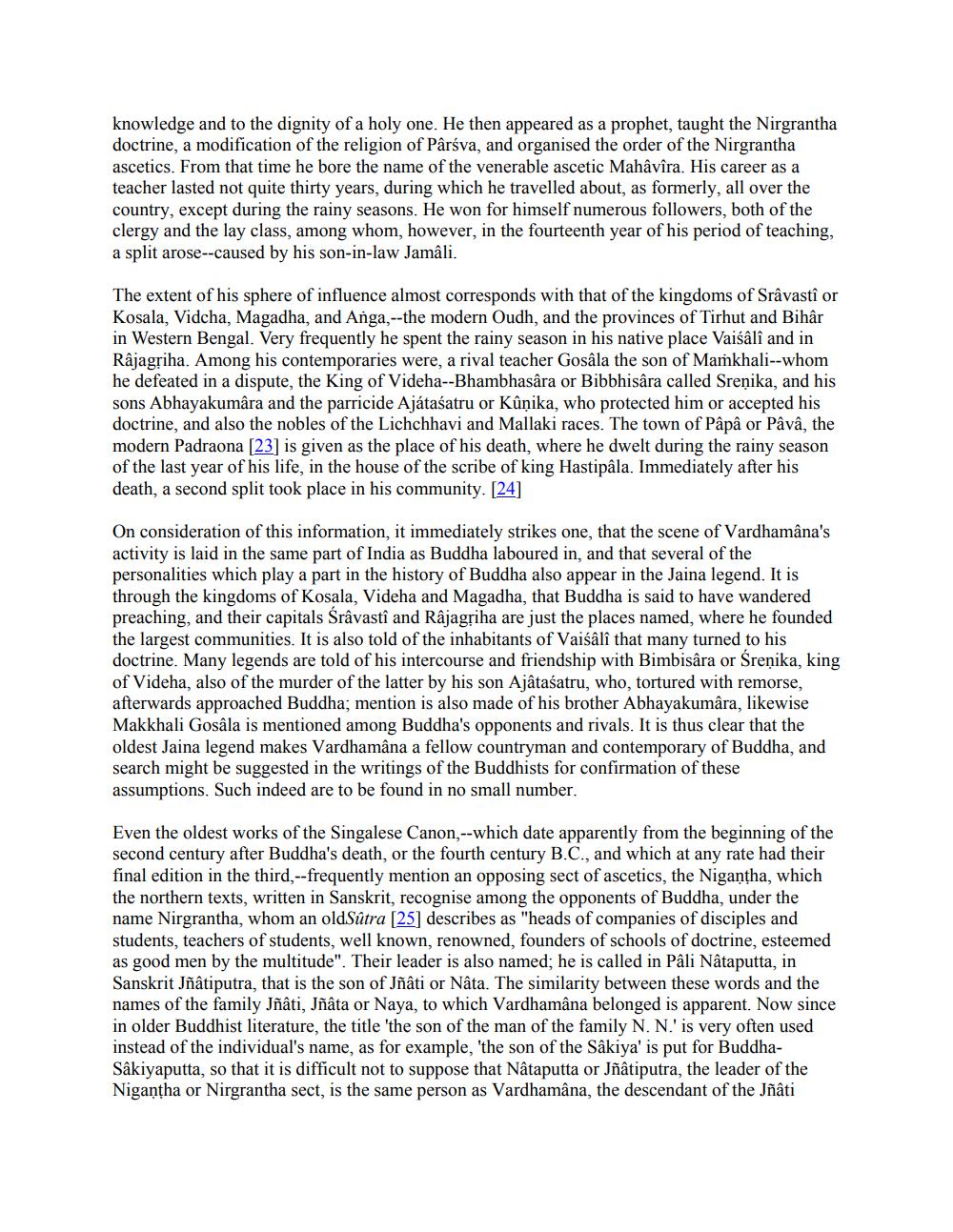________________
knowledge and to the dignity of a holy one. He then appeared as a prophet, taught the Nirgrantha doctrine, a modification of the religion of Pârśva, and organised the order of the Nirgrantha ascetics. From that time he bore the name of the venerable ascetic Mahâvîra. His career as a teacher lasted not quite thirty years, during which he travelled about, as formerly, all over the country, except during the rainy seasons. He won for himself numerous followers, both of the clergy and the lay class, among whom, however, in the fourteenth year of his period of teaching, a split arose--caused by his son-in-law Jamâli.
The extent of his sphere of influence almost corresponds with that of the kingdoms of Sravastî or Kosala, Vidcha, Magadha, and Anga,--the modern Oudh, and the provinces of Tirhut and Bihâr in Western Bengal. Very frequently he spent the rainy season in his native place Vaiśâlî and in Rajagriha. Among his contemporaries were, a rival teacher Gosala the son of Mamkhali--whom he defeated in a dispute, the King of Videha--Bhambhasara or Bibbhisara called Sreņika, and his sons Abhayakumâra and the parricide Ajátaśatru or Kûņika, who protected him or accepted his doctrine, and also the nobles of the Lichchhavi and Mallaki races. The town of Pâpâ or Pâvâ, the modern Padraona [23] is given as the place of his death, where he dwelt during the rainy season of the last year of his life, in the house of the scribe of king Hastipâla. Immediately after his death, a second split took place in his community. [24]
On consideration of this information, it immediately strikes one, that the scene of Vardhamâna's activity is laid in the same part of India as Buddha laboured in, and that several of the personalities which play a part in the history of Buddha also appear in the Jaina legend. It is through the kingdoms of Kosala, Videha and Magadha, that Buddha is said to have wandered preaching, and their capitals Srâvastî and Rajagriha are just the places named, where he founded the largest communities. It is also told of the inhabitants of Vaiśâlî that many turned to his doctrine. Many legends are told of his intercourse and friendship with Bimbisara or Sreņika, king of Videha, also of the murder of the latter by his son Ajâtaśatru, who, tortured with remorse, afterwards approached Buddha; mention is also made of his brother Abhayakumâra, likewise Makkhali Gosâla is mentioned among Buddha's opponents and rivals. It is thus clear that the oldest Jaina legend makes Vardhamana a fellow countryman and contemporary of Buddha, and search might be suggested in the writings of the Buddhists for confirmation of these assumptions. Such indeed are to be found in no small number.
Even the oldest works of the Singalese Canon,--which date apparently from the beginning of the second century after Buddha's death, or the fourth century B.C., and which at any rate had their final edition in the third,-- frequently mention an opposing sect of ascetics, the Nigantha, which the northern texts, written in Sanskrit, recognise among the opponents of Buddha, under the name Nirgrantha, whom an oldSútra [25] describes as "heads of companies of disciples and students, teachers of students, well known, renowned, founders of schools of doctrine, esteemed as good men by the multitude". Their leader is also named; he is called in Pâli Nâtaputta, in Sanskrit Jñâtiputra, that is the son of Jñati or Nâta. The similarity between these words and the names of the family Jñâti, Jñata or Naya, to which Vardhamâna belonged is apparent. Now since in older Buddhist literature, the title 'the son of the man of the family N. N.' is very often used instead of the individual's name, as for example, 'the son of the Sâkiya' is put for BuddhaSakiyaputta, so that it is difficult not to suppose that Nâtaputta or Jñâtiputra, the leader of the Nigantha or Nirgrantha sect, is the same person as Vardhamâna, the descendant of the Jñati




